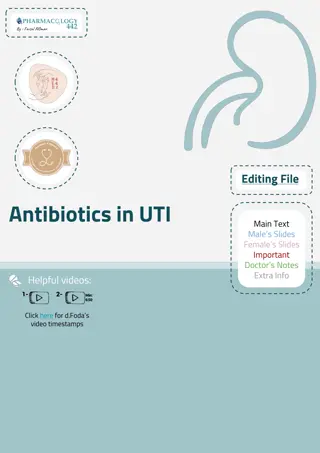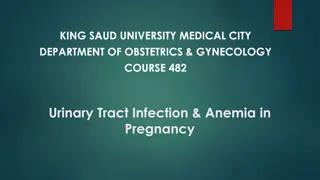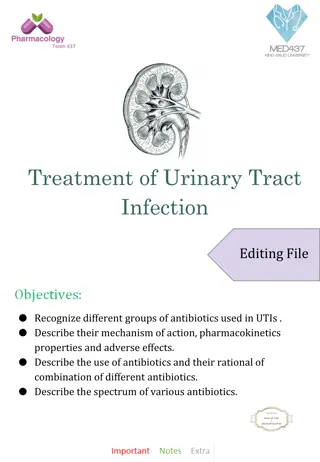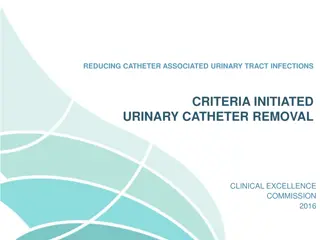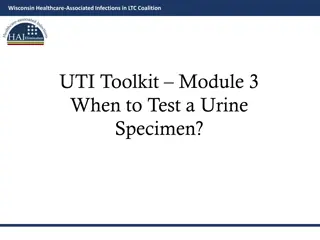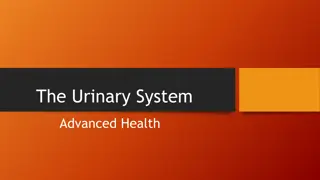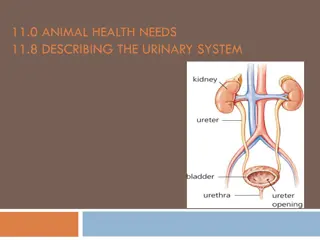Understanding Urinary Tract Wellness and Illness with Prof. Dr. Rabea M. Ali
The urinary system plays a vital role in our overall health by regulating blood volume, composition, pressure, pH balance, and more. Keeping the urinary tract healthy involves proper hydration, diet choices, and lifestyle habits. Foods like berries, yogurt, garlic, and antioxidants can promote urinary tract wellness and reduce the risk of infections and diseases.
Download Presentation

Please find below an Image/Link to download the presentation.
The content on the website is provided AS IS for your information and personal use only. It may not be sold, licensed, or shared on other websites without obtaining consent from the author. Download presentation by click this link. If you encounter any issues during the download, it is possible that the publisher has removed the file from their server.
E N D
Presentation Transcript
Urinary tract wellness and illness Prof. Dr. Rabea M. Ali
Urinary system The urinary system, also known as the renal system or urinary tract The urinary tract can be divided into the upper urinary tract and the lower urinary tract. The upper urinary tract consists of the kidneys and the ureters, and the lower urinary tract consists of the bladder and the urethra 800 2,000 milliliters (mL) of urine are normally produced every day in a healthy human. This amount varies according to fluid intake and kidney function.
The main functions of the urinary system Regulate blood volume and composition (e.g. sodium, potassium and calcium) Regulate blood pressure. Regulate pH homeostasis of the blood. Contributes to the production of red blood cells by the kidney. Stores waste product (mainly urea and uric acid) before it and other products are removed from the body.
Promoting Urinary Tract Wellness 1.Drink lots of water . according to institute of medicine, men should drink (3 liters) of water a day and women should (2.1liters) 2.Avoid beverages that irritate the bladder .carbonated drinks and caffeinated beverages like coffee 3.Watch out for spicy foods 4.Eat fiber to avoid constipation
promoting urinary tract wellness 5.Reduce the amount of meat and gluten 6.Loss weight 7. Doing kegal exercises and bladder training 8. Completely empty the bladder when urinate 9. Urinate frequently 10. Urinate after sexual intercourse
Foods Promote a Healthy Urinary Tract System Berries Berries promote urinary tract health and provide protection against infection, according to the Harvard Medical School Family Health Guide. Flavonols in berries, the compounds plants use to fight bacterial infections, may be responsible for the benefits seen in humans.
Yogurt Eating yogurt and other fermented dairy products regularly decrease the risk of urinary tract infection by up to 80 percent, also helps prevent bladder cancer. Garlic Garlic exhibited potential benefits against bladder cancer ,study published in the Medicine Reports." Garlic extract induced cell death in bladder cancer cells and inhibited cancer cells from migrating and metastasizing Antioxidants Proanthocyanidin antioxidants in cocoa, apples, grapes, peanuts and cinnamon help maintain the health of urinary tract January 2011 "Molecular
Illness of urinary tract Urinary tract infections UTI are caused by microbes such as bacteria overcoming the body's defenses in the urinary tract. The vast majority of urinary tract infections (UTIs) are caused by the bacterium Escherichia coli (E. coli), usually found in the digestive system. Chlamydia and mycoplasma bacteria can infect the urethra.
UTIs are given different names depending on where they occur. For example: 1.Abladder infection is called cystitis. 2.Aurethra infection is called urethritis. 3.Akidney infection is called pyelonephritis. 4. The ureters are very rarely the site of infection
Causes and Risk factors Several things can give you a greater chance of getting a UTI, like: 1. Being female (although men can get them too) 2. Older age, especially in people with memory problems 3. Using certain types of birth control like a diaphragm or a spermicidal 4. Menopause 5. Diarrhea or inability to control bowl movements (bowel incontinence 6. Kidney stones or other health problems that affect the flow of urine 7. Long-term constipation or when urine gets backed up (
Causes and Risk factors 8.Sexual intercourse, especially if more frequent, intense, and with multiple or new partners 9. Diabetes 10. Poor personal hygiene 11. Problems emptying the bladder completely 12. Having a urinary catheter 13. Pregnancy
Causes and Risk factors 11. procedures involving the urinary tract 12. suppressed immune system 13. immobility for a long period 14. use of spermicides and tampons 15. heavy use of antibiotics, which can disrupt the natural flora of the bowel and urinary tract
Effect of UTI in Pregnancy UTI is the most frequent medical complication of pregnancy. Physiologic changes, both hormonal and mechanical, predispose the bacterial-uric woman to an increased risk for developing acute poly-nephritis, preterm birth, and unexplained peri-natal death. Factors contributing to increased risk of disease include dilation of the ureters and renal pelvises, increased urinary pH, and glucose urea promoting bacterial growth and decrease in the ureteric muscle tone.
Signs and symptoms Asymptomatic bacteriuria Lower UTI/cystitis Upper UTI/ pylonephritis No clinical signs or symptoms Frequency Pyrexia Dysuria Loin pain Low grade fever Dysuria Suprapubic pain Rigors Clinical signs of septic shock
Common symptoms of a UTI include: 1. strong and frequent urge to urinate 2. cloudy, bloody, or strong-smelling urine 3. pain or a burning sensation when urinating 4. nausea and vomiting 5. muscle aches and abdominal pains 6. fever 7. pressure and cramping in the abdomen and lower back
Complications kidney infections. kidney damage If left untreated septicemia. increase the risk of women delivering infants that are premature or have a low birth weight.
Diagnosis 1. Urinalysis: urine sample to assess the presence of white blood cells, red blood cells, and bacteria. Screening for asymptomatic bacteriuria should be performed ideally at 12 to 16 weeks gestation on all women. The diagnosis of asymptomatic bacteriuria is made following isolation of a significant growth of one bacterial species in a clean catch specimen of urine. A clean catch specimen involves collection of a mid-stream specimen of urine after cleaning of the perineum in order to minimize contamination by skin flora.
2. Diagnostic imaging: This involves assessing the urinary tract using ultrasound, CT and MRI scanning, radiation tracking, or X-rays. Imaging of the renal tract may be warranted where pyelonephritis recurs or is slow to respond to treatment. This is to identify renal anomalies or calculi. It should also be used in cases where a renal abscess is suspected, haematuria persists or malignancy is suspected. Ultrasound (US) is the primary radiological investigation of choice for evaluation of the renal tract in pregnancy
Diagnosis 3. Urodynamics: This procedure determines how well the urinary tract is storing and releasing urine. 4. Cystoscopy: This diagnostic exam allows the doctor to see inside the bladder and urethra with a camera lens, which inserted through the urethra through a long thin tube.
Non-pharmacological measures and antimicrobial prophylaxis -Pyelonephritis may recur during pregnancy. One study showed a recurrence rate of approximately 20% during the pregnancy or the postnatal period. -A Cochrane review in 2008 of ten studies showed that cranberry juice does decrease the number of UTIs over twelve months, but no data exists as to the optimum timing and quantity of cranberry juice that needs to be consumed to prevent infection. -The focus on prevention of recurrence has focused on pharmacological and non pharmacological measures.
-A Cochrane Review showed that low dose oral nitro-furantin in combination with increased clinic review and surveillance has not shown any superiority over increased surveillance only in the prevention of recurrence of UTI. In addition, no difference was observed in the incidence of preterm birth in this group. -The use of nitro-furantin and a close surveillance policy did lead to a reduced rate of asymptomatic bacteriuria and highlighted the need for a large randomized controlled trial to determine which measures, if any, can reduce the risk of recurrent UTIs.
Clinical management Asymptomatic Bacteriuria -Antibiotic treatment of asymptomatic bacteriuria in pregnancy reduces the risk of urinary tract infection, preterm delivery and low-birth weight infants. -All women should be screened for asymptomatic bacteriuria at the first antenatal visit. - Treat women with a positive urine culture for bacteriuria detected during pregnancy with an appropriate antibiotic for the bacteria isolated and the trimester of pregnancy - Refer to local and national guidelines for the choice of antibiotic in pregnancy -A seven day course of treatment is normally sufficient - Do not prescribe trimethoprim for pregnant women with established folate deficiency or women taking folate antagonists.
Symptomatic Bacteriuria - Urine culture is the investigation of choice in symptomatic bacteriuria. - Treat symptomatic bacteriuria with an antibiotic in accordance with local guidance. - Take a single sample for urine culture before empiric treatment is started. - Women with symptomatic bacteriuria with systemic signs of infection should be admitted for intravenous antibiotics depending the result of blood cultures and the urine culture - In cases where a clinical improvement fails to occur with 24 hours of instigating treatment or where there are additional co- morbidities additional senior medical and microbiology advice should be sought - Renal imaging should be considered if renal pathology is suspected or in cases that recur
Pharmacological management General Principles of antimicrobial use Choosing the right antimicrobial is an essential part of managing pregnant Patients with urinary tract infections. It is not only important to choose the right drug, but also consideration should be given to selecting the right dose and treatment duration. By effectively treating urinary tract infections it is hoped to reduce the risk of maternal sepsis, polynephritis, preterm labor and also adverse outcomes for the fetus. Consideration should also be given to potential teratogenicity when choosing an antimicrobial. This may be more difficult in the setting of penicillin allergy but the risks and benefits should be explained to the patient.
Nursing Care: Health Promotion to Prevent UTI a. Fluid intake 2 2.5 L daily, and urinate frequently. Drink more if hot weather or strenuous activity is involved b. Empty bladder every 3 4 hours c. Females 1. Cleanse perineal area from front to back. 2. Void before and after sexual intercourse 3. Maintain integrity of perineal tissues -Avoid use of commercial feminine hygiene products or douches in the genital area. - Wear cotton underwear and loose-fitting clothing to keep the area around the urethra dry. - . .
-Maintain acidity of urine (use of cranberry juice, take Vitamin C, avoid excess milk and milk products, sodium bicarbonate) -Avoid fluids such as alcohol and caffeine that can irritate the bladder. -Keep the genital area clean. - Showers are preferred to baths and avoid using oils. - Sanitary pads or menstrual cups are preferred to tampons. -Avoid using a diaphragm or spermicide for birth control. -
Nursing Diagnoses a. Pain: Additional interventions include warmth, analgesics, urinary analgesics, antispasmodic medications. b. Impaired Urinary Elimination c. Ineffective Health Maintenance: Clients must complete full course of antibiotic therapy. Home Care: Teaching: prevention of infection and use alternatives to indwelling catheter whenever possible
Urinary incontinence (UI) involuntary urination, also uncontrolled leakage of urine. It is a common and distressing problem, which may have a large impact on quality of life. Bladder symptoms affect women of all ages. However, bladder problems are most prevalent among older women. Women are twice as likely as men to experience incontinence, One reason why women are more affected is the weakening of pelvic floor muscles by pregnancy. known as is any
There are four main types of incontinence 1.Urge incontinence due to an overactive bladder 2. Stress incontinence:due to poor closure of the bladder,the most common types in women 3.Overflow incontinence: due to either poor bladder contraction or blockage of the urethra 4. Functional incontinence due to medications or health problems making it difficult to reach the bathroom
Causes Urologic causes 1. detrusor over activity, 2. poor bladder compliance, 3. urethral hypermobility 4.intrinsic sphincter deficiency. Non-urologic causes may include: 1. infection 2. medication 3. pregnancy and childbirth 4. psychological factors, 5. stool impaction, 6. restricted mobility. 7. Older age
Diagnosis 1. Stress test the patient relaxes, then coughs vigorously as the doctor watches for loss of urine. 2. Urinalysis urine is tested for evidence of infection, urinary stones, or other contributing causes. 3. Ultrasound sound waves are used to visualize the kidneys, ureters, bladder, and urethra. 4. Cystoscopy a thin tube with a tiny camera is inserted in the urethra and used to see the inside of the urethra and bladder. 5. Urodynamics various techniques measure pressure in the bladder and the flow of urine.
Treatment Treatment will depend on several factors, such as the type of incontinence, the patient's age, general health, and their mental state. 1. Bladder training -- Delaying the event: The aim is to control urge. The patient learns how to delay urination whenever there is an urge to do so. - Double voiding: This involves urinating, then waiting for a couple of minutes, then urinating again. - Toilet timetable: The person schedules bathroom at set times during the day, for example, every 2 hours.
2.Medications Anti cholinergics calm overactive bladders and may help patients with urge incontinence. Topical estrogen may reinforce tissue in the urethra and vaginal areas and lessen some of the symptoms. Imipramine (Tofranil) is atricyclic antidepressant. 3.Medical devices 1. Urethral inserts: A woman inserts the device before activity and takes it out when she wants to urinate. 2. Pessary: A rigid ring inserted into the vagina and worn all day. It helps hold the bladder up and prevent leakage.
3. Radiofrequency therapy: Tissue in the lower urinary tract is heated. When it heals, it is usually firmer, often resulting in better urinary control. 4.Botox: Injected into the bladder muscle, this can help those with an overactive bladder. 5.Bulking agents: Injected into tissue around the urethra, these help keep the urethra closed. 6.Sacral nerve stimulator: This is implanted under the skin of the buttock. A wire connects it to a nerve that runs from the spinal cord to the bladder. The wire emits an electrical pulse that stimulates the nerve, helping bladder control.
4.Surgery 1.Sling procedures: A mesh is inserted under the neck of the bladder to help support the urethra and stop urine from leaking out. 2.Colposuspension: Lifting the bladder neck can help relieve stress incontinence. 3.Artificial sphincter: An artificial sphincter, or valve, may be inserted to control the flow of urine from the bladder into the urethra. 5.Other options Urinary Catheter. Absorbent pads
Interstitial cystitis (IC) Also known as bladder pain syndrome (BPS), is a type of chronic pain that affects the bladder. In the United States and Europe it is estimated that around 0.5% of people are affected. Women are affected about five times as often as men. Signs and symptoms Supra-pubic pain, urinary frequency painful sexual intercourse waking up from sleep to urinate. painful urination. depression and lower quality of life.
Diagnosis Urinalysis, urine culture. Cystoscopy: Ulceration or inflammation may be seen, Ultrasound scanning Causes Unknown. Neurologic cause, Allergic Genetic Stress-psychological. Infection
Treatment 1. First-line treatments: patient education, self care ,diet modification, stress management 2.Second-line treatments: physical therapy, oral medications (amitriptyline, cimetidine or hydroxyzine), bladder instillations , lidocaine. 3. Third-line treatments: treatment of Hunner's ulcers (laser, fulguration or triamcinolone injection). 4.Fourth-line treatments: neuromodulation (sacral or pudendal nerve) 5.Fifth-line treatments: cyclosporineA, botulinum toxin (BTX-A) 6.Sixth-line treatments: surgical intervention (urinary diversion, augmentation, cystectomy).
Thank you Thank you



